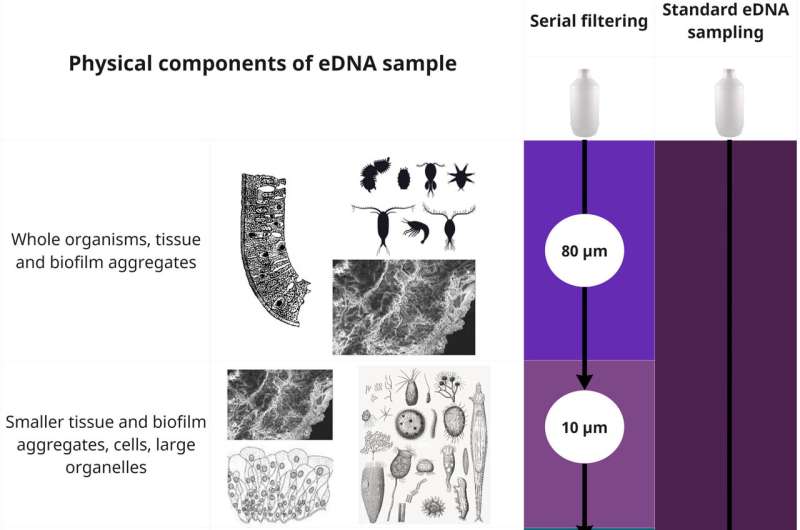This article has been reviewed according to Science X's editorial process and policies. Editors have highlighted the following attributes while ensuring the content's credibility:
fact-checked
trusted source
proofread
eDNA explained: Unlocking nature's hidden biodiversity

Environmental DNA—or eDNA for short—is DNA left behind in the environment like fingerprints at a crime scene.
We can collect eDNA in soil, water or air samples and read the DNA sequences present. Then we match the sequences to a reference library to identify the species present at the scene. Collecting eDNA is a non-invasive method to study biodiversity and monitor ecosystems, allowing us to track species presence without direct observation or disturbance.
But what is eDNA, exactly? Would the answer help us collect eDNA from the environment more effectively and work with it better in the lab? We decided to find out.
eDNA in the sea
Its name might suggest eDNA is simply naked fragments of DNA floating freely in the environment, but the answer is more complex.
Dr. Haylea Power is a research scientist with our Environomics Future Science Platform. She said eDNA has never been well characterized.
"We know how to collect eDNA and work with it in the lab, but we've never known exactly what physically we were working with," Haylea said.
"We think this knowledge would be helpful for collecting eDNA more effectively. It might also help us detect species that have proved difficult to detect using eDNA, perhaps because their eDNA is not in the physical form we thought it was."
Haylea's team collected seawater from Mettam's pool, a lagoon in Perth, Western Australia. Then they filtered the water through filter paper to separate the eDNA present in the water.
Instead of using a standard-sized filter paper, the team filtered the sea water through a series of filter papers. This allowed them to separate particles starting at 80 micrometers all the way down to particles less than 0.22 micrometers. (For comparison, office printer paper is about 100 micrometers thick and plastic cling wrap is about 10 micrometers thick.)
They used microscopy to visualize the particles trapped by the different sized filter papers. Following this, they analyzed the eDNA from each filter to compare the detectable species. The paper, "What is Environmental DNA (eDNA)?," was published in the journal Environmental DNA.
What eDNA is made of
The team discovered eDNA is not just fragments of DNA floating in the sea.
"eDNA is present a variety of different ways in seawater," Haylea said.
"It can be embedded in single cells, tissue fragments, complete microscopic organisms, and aggregates of these materials embedded within biofilms."
Importantly, the team found the choice of filter size can impact the results of research using eDNA. This is because the optimal filter pore size differs for different kinds of living things.
"The optimal pore size for fish was 5 micrometers, but for bacteria it was 80 micrometers," Haylea said.
"This was a surprise because bacteria are tiny compared to fish.
"If you choose the wrong size filter, you can accidentally filter out entire groups of species. This means there is huge scope to improve the way we collect eDNA from marine environments, and how we work with it in the lab.
"The knowledge that different filter sizes can select for different groups of lifeforms will be useful.
"In the future, we would like to read the eDNA in a scoop of sea water and not just end up with a list of the species present. The ultimate goal is for eDNA to result in better management of the marine environment."
More information: Haylea Power et al, What is environmental DNA?, Environmental DNA (2023). DOI: 10.1002/edn3.497
Provided by CSIRO




















